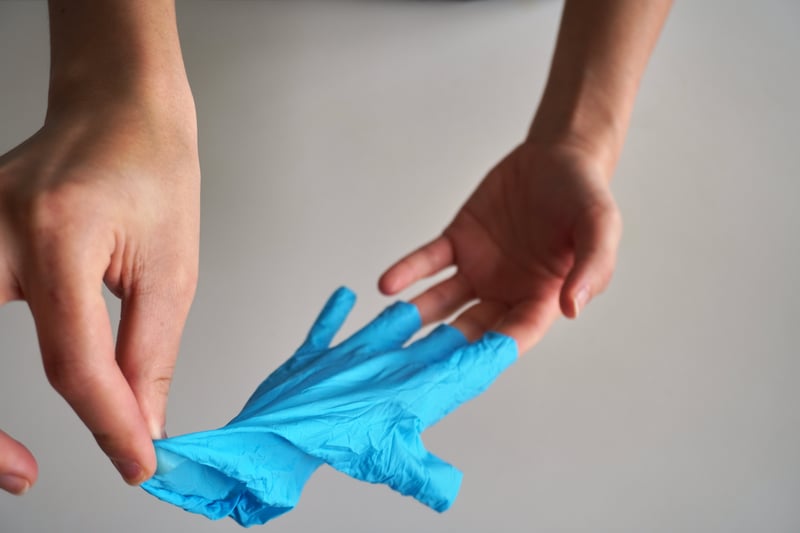Patient Resources
Get Healthy!
Latex Allergy: What It Is, Causes, Symptoms & Treatments
- May 9, 2023
- Ann Schreiber
- HealthDay Reporter

Having a latex allergy is no fun, but it can be a real challenge for health professionals who have to work with a wide variety of medical equipment that can contain the allergen.
Latex allergy can trigger a range of symptoms, from itchy hives and rashes to life-threatening anaphylaxis. While StatPearls estimates that it only affects 1% to 2% of the population, it can be a source of frustration for those who have it. To make matters worse, the same report suggests that latex allergy is more likely in health care workers, who are surrounded by items containing latex, including stethoscopes, electrode pads, syringes, respirators, gloves, drainage tubes and more.
Understanding latex allergy is crucial, especially for those frequently exposed to latex-containing products. Here, experts explain latex allergy, including its causes, symptoms, risk factors, testing methods and available treatments.
What is a latex allergy?
A latex allergy occurs when the immune system responds abnormally to latex, which comes from the sap of the rubber tree, Hevea brasiliensis, found in Africa and Southeast Asia. Latex is found in a plethora of medical equipment, and people at higher risk of developing latex allergy include health care workers, people with certain medical conditions, and individuals with multiple surgeries or medical procedures, according to the Mayo Clinic. Fortunately, various treatments and preventive measures are available for those with latex allergies, including avoiding exposure to latex-containing products, taking antihistamines and carrying an epinephrine pen, for any potential emergency.
Latex allergy causes and risk factors
According to the American College of Allergy, Asthma & Immunology, latex allergy can be caused by repeated exposure to natural rubber latex, which triggers an immune system response.
Interestingly, some individuals with latex allergies may also experience allergies to certain foods, such as bananas, avocados and kiwis. Moreover, condoms and other latex-containing products, such as gloves and balloons, can trigger allergic reactions. Therefore, it is crucial to know the various latex sources, take preventive measures and understand latex allergy treatments.
Latex allergy symptoms
Dr. Cindy Xi, a clinical assistant professor of medicine at the University of Southern California's Keck School of Medicine, said in a recent article that, "Latex allergy was the most prevalent in the 1990s, when latex gloves were more common. Since the introduction of low-latex or latex-free gloves, new cases of latex allergy have dramatically decreased. And now that most medical centers are latex-free or almost latex-free, the overall incidence of latex allergy has also dramatically decreased."
But that doesn't mean latex allergy has gone away. For that reason, it's critical to know what to look for and understand latex allergy symptoms. These symptoms of latex allergy can vary from mild to severe and occur within minutes of exposure or several hours later. According to the Cleveland Clinic, the most common latex allergy symptoms are as follows:
- Itching
- Skin rash
- Redness
- Hives or urticaria
- Swelling
- Runny or stuffy nose
- Sneezing
- Itchy, watery eyes
- Scratchy throat
- Difficulty breathing or shortness of breath
- Wheezing
- Chest tightness
- Anaphylaxis
A rash may be one of the most frequently occurring of these symptoms. The Cleveland Clinic says that when someone with a latex allergy is exposed to latex, the affected area may also develop raised welts that resemble hives, indicating an immune system response. This type of skin irritation typically occurs within 15 to 30 minutes of exposure to latex.
What happens during a latex allergy test?
During a latex allergy test, a health care provider will typically use a skin-prick test or a blood test to determine whether or not an individual is allergic to the substance, the Cleveland Clinic states. In a skin-prick test, the provider will place a small amount of latex extract on the skin and then use a tiny needle to prick the skin, allowing the extract to enter the skin.
If the individual is allergic to latex, they will develop a small, raised welt or bump on the skin within 15 to 20 minutes. This test is relatively quick and straightforward and can be done in a doctor's office or clinic. However, if a skin-prick test is inconclusive or not feasible, a blood test may be used to measure the presence of latex-specific antibodies in the bloodstream. Both tests are safe and effective methods for diagnosing latex allergy.
Latex allergy treatments
Over-the-counter antihistamines such as Benadryl may help relieve symptoms such as itching, hives and swelling in an allergic reaction. Further, the Allergy & Asthma Network indicates that prescription medications such as corticosteroids and epinephrine can help manage symptoms such as difficulty breathing and anaphylaxis.
If you are diagnosed with a latex allergy, you will likely be asked by your medical provider or allergist to carry an epinephrine auto-injector, such as an EpiPen, if you have a history of severe allergic reactions to latex. Immunotherapy or allergy shots may be recommended to help reduce the severity of the allergy over time.
As with any allergy, be sure to partner with your health care provider to develop a personalized treatment plan and take preventive measures to avoid exposure to latex.

